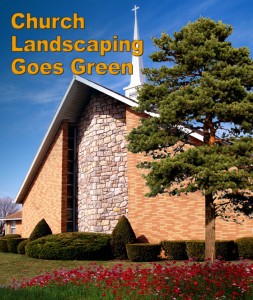How to Make Church Landscaping More Eco-Friendly
Energy efficiency extends beyond the front door in green churches. Strategic church landscape design reduces energy consumption and saves water.
Green Churches Sow Seeds that Reap Rewards
Beautiful landscaping makes a church seem more inviting. When properly planned, church landscape design also helps cut energy bills for eco-friendly green churches.
 Here are some church landscape ideas and tips for making the most of the green spaces around your worship center:
Here are some church landscape ideas and tips for making the most of the green spaces around your worship center:
1. USE NATIVE PLANTS. The trees, shrubberies, and flowers native to an area not only prove hardier, but also generally require less water and care than more exotic plants.
2. PLANT TREES. Mature trees planted close to buildings shade the structure, helping cut energy usage as much as 10% annually. In cities, trees also help mitigate the urban heat island effect in summer. Tree shaded areas are as much as 10°F cooler than paved areas and are a great inclusion for any church landscape design.
Trees inhale carbon dioxide and pollutants, cleaning the surrounding air. One tree absorbs as much as 40 pounds of carbon dioxide per year. Trees release life-sustaining oxygen, replenishing and refreshing the air.
Trees also create a buffer from traffic noise.
Tree covering increases the church’s property value, too.
3. CHOOSE DECIDUOUS TREES. Deciduous trees work best for green churches— especially in urban areas. Trees with thick foliage shade in summer. Bare in winter, deciduous trees let sunlight through to help warm buildings.
4. ADD GREEN ISLANDS. Break up vast, stark parking areas with small green “islands” of plants and trees. The result is a more visually appealing church landscape design— and lowers summer temperatures by shading the pavement.
5. CHOOSE LIGHTER PAVEMENT. When building or resurfacing parking areas, choose a light colored paving material in warm climates. On a hot summer day, dark asphalt surfaces absorb heat. Parking lot surfaces may reach 150°F or more. Parking lot surfaces hold heat after sundown, driving up nighttime temperatures, too. Overheated air around the church pushes air conditioning demands.
In extremely cold climates, darker parking lot surfaces are beneficial. Darker pavement warms surrounding air in winter, helping melt ice and snow faster.
6. USE MULCH. Mulching around trees and in plant beds holds moisture in. Mulching also discourages weed growth, reducing the need for harsh chemical treatments.
7. LEAVE CLIPPINGS. Mow lawn areas with mower height set on two to three inches. Grass at this length absorbs water better, diminishing wasteful runoff. Run mower without a grass bagger. Clippings left in the lawn add much need nutrients and eliminate disposal problems.
8. AERATE LAWNS. Small holes punched six to ten inches apart allow the soil to absorb water better, reducing runoff.
9. CONSERVE WATER. Choose plants with low water demands. Watering early or late in the day minimizes water lost to evaporation. Water only as long as needed to dampen soil without wasting water in runoff. Consider drip irrigation for shrubbery and hedge areas.
10. ADD A GARDEN. If the size of the lot permits, add a contemplative garden. Fountains, small rock waterfalls, small fishponds, birdbath and feeders, benches, trees, shrubs, flowers, and wandering walkways create an atmosphere of serenity. Parishioners will love the chance to get away from the hustle and bustle to pray in peaceful surroundings.
Green Churches Start with Steel
RHINO Steel Building Systems create green churches and auxiliary buildings.
Pre-engineering eliminates wasted framing materials. Eco-friendly RHINO structures contain recycled steel. Options like skylights, high-performance insulation systems, reflective roofing, and extended overhangs increase energy savings.
Call today — 940.383.9566— to discuss ways your congregation can build stronger, safer, smarter, greener church structures with the right church landscape design.
